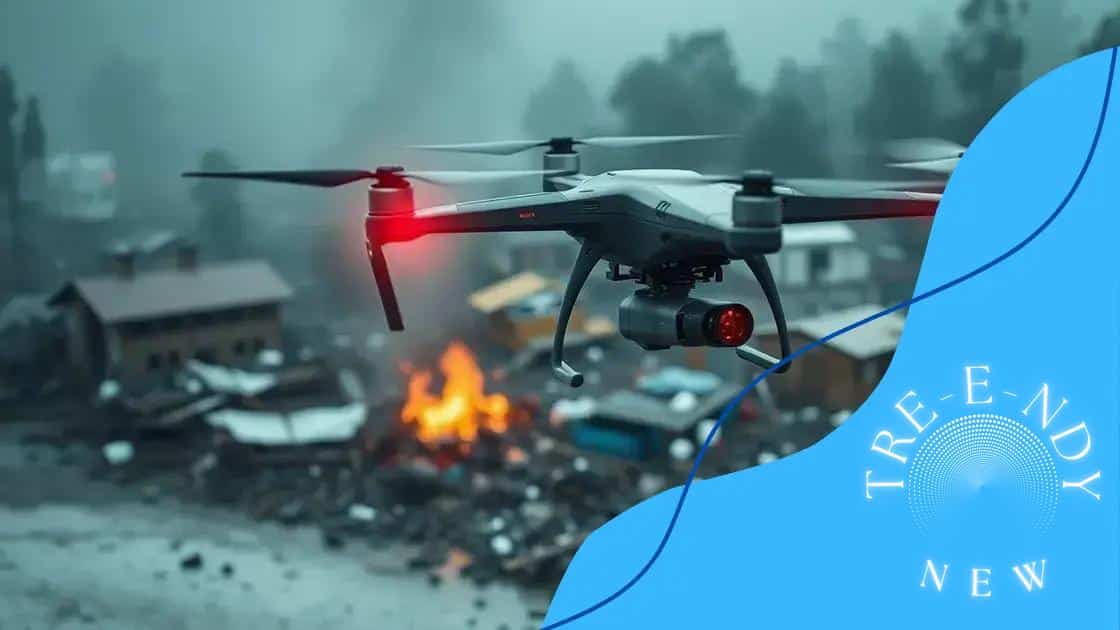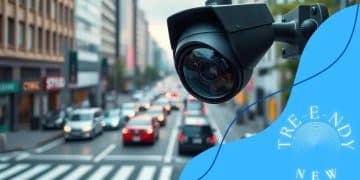Drone technology in emergency response: saving lives

Drone technology in emergency response enhances efficiency, providing rapid data collection, autonomous operations, and improved coordination during crises, ultimately saving lives and resources.
Drone technology in emergency response is changing the landscape of crisis management. Imagine swift aerial views during natural disasters, helping responders save lives. Curious about how this works? Let’s explore!
The role of drones in disaster management
In recent years, drones have become essential tools in disaster management. These flying devices can quickly access tough terrains, providing crucial data when it’s needed most. They play a vital role in enhancing response strategies during emergencies.
Data Gathering and Assessment
Drones are used extensively for gathering real-time information. Their ability to quickly survey affected areas can save lives.
- Imaging for mapping damage
- Assessing infrastructure stability
- Collecting temperature data for fires
Additionally, they help in locating victims and understanding the scale of destruction. By utilizing various sensors, drones can provide accurate assessments, guiding first responders effectively.
Delivery of Supplies
Another significant function of drones in disaster management is the delivery of essential supplies. When traditional methods are too slow or inaccessible, drones can transport food, medical supplies, and other necessities to those in need.
- Fast delivery to remote areas
- Reducing traffic in disaster zones
- Improving logistics during crises
This capability is crucial during natural disasters, where every minute counts in saving lives. Furthermore, as technology evolves, the potential uses of drones continue to expand.
Drones ensure efficient communication and coordination between teams. By maintaining aerial views of disaster zones, they help manage resources while keeping responders safe.
In summary, the role of drones in disaster management is reshaping how we respond to crises. With their ability to gather data and deliver supplies, they are becoming indispensable in saving lives and mitigating further damage.
Advantages of drone technology in emergencies
The advantages of drone technology in emergencies are numerous and impactful. These devices offer unique capabilities that can enhance response efforts, making them vital in crisis situations.
Speed and Efficiency
First and foremost, drones can operate faster than traditional response methods. They can quickly survey large areas, providing real-time information.
- Rapid aerial assessments
- Immediate delivery of supplies
- Access to hard-to-reach locations
This speed allows emergency teams to act swiftly, reducing the risk to lives and property. The use of drones significantly shortens the time it takes to gather crucial data, which is essential during a crisis.
Cost-Effectiveness
Another key benefit of drone technology in emergencies is its cost-effectiveness. Deploying drones can be less expensive compared to traditional methods, like helicopters or ground vehicles.
- Lower operational costs
- Reduced manpower needs
- Efficient use of resources
This makes it feasible for more organizations, including local governments, to utilize drones for emergency response.
Furthermore, with robots handling the more dangerous tasks, human responders can focus on other critical areas, ensuring their safety while maximizing effectiveness.
The versatility of drones is also remarkable. Their adaptability means they can be equipped with various technologies, such as thermal imaging and 3D mapping, tailored to specific emergency needs.
In addition, by providing continuous aerial support, drones enhance situational awareness for response teams. This improved visibility leads to better decision-making, ultimately saving lives.
Case studies: successful drone deployments

Numerous case studies highlight the success of drones in various emergency situations. These real-world examples show how drone technology has positively impacted disaster response.
Hurricane Harvey
During Hurricane Harvey in 2017, drones were deployed to assess the extensive flooding in Texas. They provided crucial aerial views of affected areas, helping emergency responders plan their actions effectively.
- Captured images of submerged neighborhoods
- Identified locations for rescue operations
- Facilitated real-time data sharing with response teams
This use of drones enabled rapid decision-making, ensuring that help reached those who needed it most.
California Wildfires
In California’s devastating wildfires, drones played a key role in monitoring the spread of flames. Their thermal imaging capabilities allowed firefighters to spot hotspots and assess risks remotely.
- Improved situational awareness for fire crews
- Monitored fire behavior in inaccessible areas
- Helped in mapping fire boundaries accurately
The ability to adapt in real-time helped response teams allocate resources effectively, saving both lives and properties.
These case studies demonstrate how drones enhance communication and coordination among emergency response teams. Their use provides a clearer picture of unfolding situations, making it easier to design effective intervention strategies.
By learning from these successful deployments, other regions can better understand how to incorporate drone technology into their emergency response plans.
Challenges and limitations of using drones
While drones offer many advantages in emergency response, there are also several challenges and limitations to consider. Understanding these issues is key to maximizing their effectiveness.
Regulatory Hurdles
One significant challenge is the regulatory environment surrounding drone technology. Different countries have varying laws regarding the use of drones for commercial and emergency purposes.
- Strict airspace regulations
- Licensing requirements for operators
- Limitations on flight altitude and range
Navigating these regulations can slow down the deployment of drones in urgent situations, potentially delaying critical responses.
Technical Limitations
Drones also face technical limitations. Factors such as battery life and payload capacity can affect their performance during operations.
- Limited flight time, typically 20-30 minutes
- Weight restrictions on sensors and equipment
- Dependence on GPS and potential signal loss
These issues can hinder the ability of drones to operate effectively in remote or challenging environments. For example, a drone may have to return to base before completing its mission if the battery runs low.
Furthermore, environmental conditions like rain, wind, or snow can greatly affect drone functionality. Using drones in poor weather conditions might not be feasible, which limits their usability in emergencies.
Finally, there is the question of data privacy and security. The use of drones for surveillance may raise concerns among the public, leading to resistance against their deployment. Balancing efficient response with privacy rights is an ongoing challenge.
Future trends in drone technology for emergencies
The future of drone technology in emergencies looks promising, with several trends shaping how these devices will be used. As technology advances, we can expect drones to become even more integral to emergency response efforts.
Autonomous Operations
One of the most significant trends is the move towards greater autonomy in drones. Future systems may be able to make decisions on their own without human intervention.
- Automated search and rescue missions
- Real-time hazard assessment
- Self-adjusting flight paths based on obstacles
This autonomy can speed up responses during crises when time is critical. As algorithms and sensor technology improve, drones will be able to navigate complex environments more effectively.
Enhanced Integration with AI
Another exciting trend is the integration of artificial intelligence (AI) with drone technology. AI can analyze data collected by drones swiftly, providing actionable insights to responders.
- Predictive analytics for disaster scenarios
- Improved image recognition for identifying hazards
- Data fusion for comprehensive assessments
This capability can make emergency responses smarter and more efficient, ultimately saving lives.
Moreover, the use of drones is also expected to expand into specialized applications. For example, we might see drones designed specifically for wildfire management or urban search and rescue operations.
As public acceptance grows, collaborations between government agencies, private companies, and nonprofits will likely increase. These partnerships can drive innovations and develop standardized protocols for utilizing drones in emergencies.
Finally, advancements in battery technology will extend flight times and enable drones to cover larger areas without needing to recharge, further enhancing their utility during crises.
The evolution of drone technology in emergency response shows great promise. As we have seen, these devices enhance our ability to manage crises effectively. From autonomous operations to improved integration with artificial intelligence, the future is bright for drones. By overcoming challenges such as regulatory hurdles and technical limitations, we can unlock their full potential. Adopting these advancements will make emergency responses quicker, safer, and more efficient. The journey of drones in emergency management is just starting, and their impact will only grow in the coming years.
FAQ – Frequently Asked Questions about Drone Technology in Emergency Response
What are the main advantages of using drones in emergencies?
Drones offer speed, efficiency, and unique data-gathering capabilities, enhancing emergency response efforts significantly.
How do regulatory challenges affect drone operations?
Regulatory hurdles can limit drone usage due to strict airspace regulations, requiring licenses, and managing flight operations.
What future trends can we expect in drone technology?
Future trends include increased autonomy, enhanced AI integration for data analysis, and improvements in battery life to extend operations.
What challenges do drones face in adverse weather conditions?
Drones may struggle in bad weather, such as high winds or heavy rain, which can affect their flight performance and safety.





